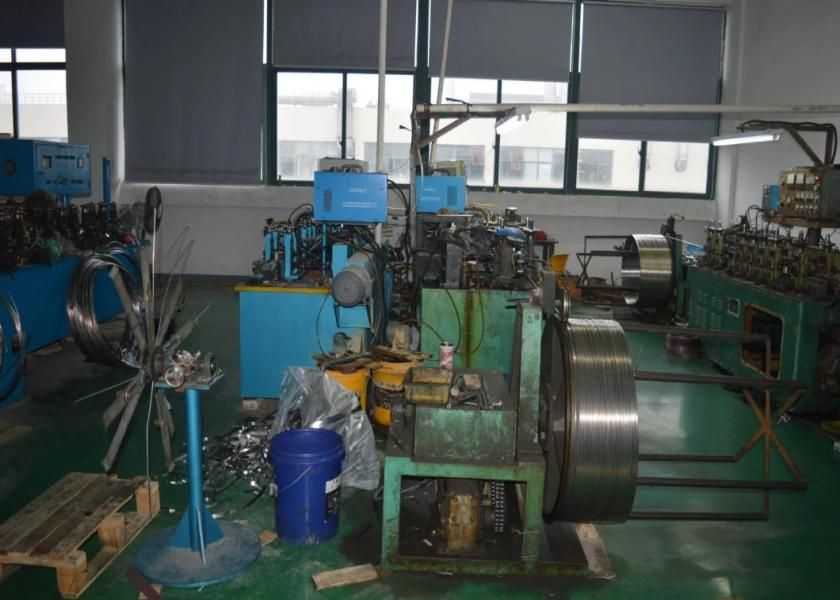2205 stainless steel 4*1mm capillary coiled tubing
2205 Duplex Stainless Steel coiled capillary tubing
Mechanical Properties of Duplex Stainless Steel Grade 2205
2205 stainless steel 4*1mm capillary coiled tubing
| Grade | Tensile Str (MPa) min |
Yield Strength 0.2% Proof (MPa) min |
Elongation (% in 50mm) min |
Hardness-Rockwell C (HR C) | Hardness-Brinell (HB) |
|---|---|---|---|---|---|
| 2205 | 621 | 448 | 25 | 31 max | 293 max |
Physical Properties of Duplex Stainless Steel 2205
2205 stainless steel 4*1mm capillary coiled tubing
| Density(Kg.m-1) | 7810 |
|---|---|
| Magnetic Permeability | <50 |
| Young’s Modulus(N/mm2) | 190*10^3 |
| Specific Heat,20°℃(J.Kg-1.°K-1) | 400 |
| Specific Electrical Resistance,20℃(uO.m) | 0.85 |
| Thermal conductivity,20℃ | 15 |
| Mean coefficient of thermal expansion | 11*10^6 |
2205 Duplex Stainless Steel Chemical Composition:
2205 stainless steel 4*1mm capillary coiled tubing
| Grades | C | Mn | Si | P | S | Cr | Mo | Ni | N |
|---|---|---|---|---|---|---|---|---|---|
| 2205 (S31803) |
≤0.03 | ≤2.0 | ≤1.0 | ≤0.03 | ≤0.02 | 21.0≤Cr≤23.0 | 2.5≤Mo≤3.5 | 4.5≤Ni≤6.5 | 0.08≤N≤0.20 |
| 2205 (S32205) |
≤0.03 | ≤2.0 | ≤1.0 | ≤0.03 | ≤0.02 | 21.0≤Cr≤23.0 | 3.0≤Mo≤3.5 | 4.5≤Ni≤6.5 | 0.14≤N≤0.20 |
2205 stainless steel 4*1mm capillary coiled tubing
Standards of Duplex Ss 2205:
- ASTM/ASME: A240 UNS S32205/S31803
- EURONORM: 1.4462 X2CrNiMoN 22.5.3
- AFNOR: Z3 CrNi 22.05 AZ
- DIN: W.Nr 1.4462
Applications of Duplex Ss 2205
2205 stainless steel 4*1mm capillary coiled tubing
Some of the typical applications of duplex stainless steel grade 2205 are listed below:
- Oil and gas exploration
- Processing equipment
- Transport, storage, and chemical processing
- High chloride and marine environments
- Paper machines, liquor tanks, pulp, paper digesters, etc.
Features of Duplex Ss 2205
2205 stainless steel 4*1mm capillary coiled tubing
Duplex Stainless Steel 2205 Compared with 316L and 317L austenitic stainless steels, 2205 is superior in anti-pitting and crevice corrosion resistance. It has high corrosion resistance. Compared with austenite, its thermal expansion coefficient is lower, thermal conductivity is higher.
Duplex Stainless Steel 2205 has twice the compressive strength of austenitic stainless steel, allowing designers to reduce their weight compared to 316L and 317L. The 2205 alloy is especially suitable for use in the -50° F/ + 600° F temperature range and can be used for lower temperatures under severe restrictions (especially for welded construction).
The corrosion resistance of 2205 Duplex Stainless Steel
2205 stainless steel 4*1mm capillary coiled tubing
- Uniform corrosion, The corrosion resistance of duplex stainless steel 2205 is superior to 316L and 317L in most environments due to chromium content (22%), molybdenum (3%), and nitrogen content (0.18%).
Local anti-corrosion, The content of chromium, molybdenum, and nitrogen in duplex stainless steel 2205 makes it highly resistant to pitting and crevice corrosion in oxidizing and acidic solutions. - Anti-stress corrosion, The 2205 duplex structure of stainless steel helps to improve the resistance to stress corrosion cracking of stainless steel. At a certain temperature, under the conditions of tension, oxygen, and chloride, chloride stress corrosion occurs in austenitic stainless steel. As these conditions are not easily controlled, the use of 304L, 316L, and 317L are limited in this regard.
- Anti-corrosion fatigue, Dual-phase steel 2205 high strength and corrosion resistance to high corrosion resistance fatigue strength. The processing equipment is susceptible to corrosive environments and loading cycles, and the duplex stainless steel 2205 features are well suited for such applications.
Metallography about Duplex Ss 2205 uns s31803
The chemical composition of the 2205 duplex steel gives the desired microstructure of 50 ϫ / 50 after 1900 / 1922° F(1040 °C / 1080°C) solid solution annealing. If the heat treatment temperature is higher than 2000 ° F, may lead to an increase in ferrite composition. Like other duplex stainless steels, 2205 alloys are susceptible to intermetallic phase precipitation.
The intermetallic phase precipitates between 1300° F and 1800 ° F and precipitates fastest at 1600° F. Therefore, we need to test 2205, to ensure that no intermetallic phase, the test reference ASTM A 923.






